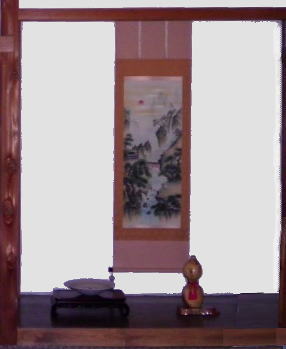
|

|
Last update June 8, 2021
観光用語解説
床の間 (とこのま)

 「床の間」が日本建築の中で成立するのは、室町時代後期のこと。以前は「床の間」じゃなくて「床」って呼ばれてたのよ。「床」って言うのは、他の部分より一段高くなっている場所を指していたらしいのね。
「床の間」が日本建築の中で成立するのは、室町時代後期のこと。以前は「床の間」じゃなくて「床」って呼ばれてたのよ。「床」って言うのは、他の部分より一段高くなっている場所を指していたらしいのね。 豊臣秀吉なんかはよく、自分から「床の間」に座ってたらしいわよ。つまり、武士の威厳を誇示するためのものだったようね。江戸時代とかになると、大げさな床の間がどんどん作られたらしいわ。でもね、床の間ってのは、武士だけのためのもので、町民や農民の家には当然、床の間なんてなかったわけ。ずっと後になってから、豪農・豪商の家には造られるようになったらしいけど、なぜかというと、そういう名門の農家や商家には、武士が来るのよ。そのときのために、わざわざ、普段自分たちは足を踏み入れることもない床の間の部屋を造ったんだって。
豊臣秀吉なんかはよく、自分から「床の間」に座ってたらしいわよ。つまり、武士の威厳を誇示するためのものだったようね。江戸時代とかになると、大げさな床の間がどんどん作られたらしいわ。でもね、床の間ってのは、武士だけのためのもので、町民や農民の家には当然、床の間なんてなかったわけ。ずっと後になってから、豪農・豪商の家には造られるようになったらしいけど、なぜかというと、そういう名門の農家や商家には、武士が来るのよ。そのときのために、わざわざ、普段自分たちは足を踏み入れることもない床の間の部屋を造ったんだって。Toko-no-ma (Decorative Alcove)
 In early times, it was merely called "
In early times, it was merely called " Initially, it was devised as a seat for a person of higher class. A record says that
Initially, it was devised as a seat for a person of higher class. A record says that